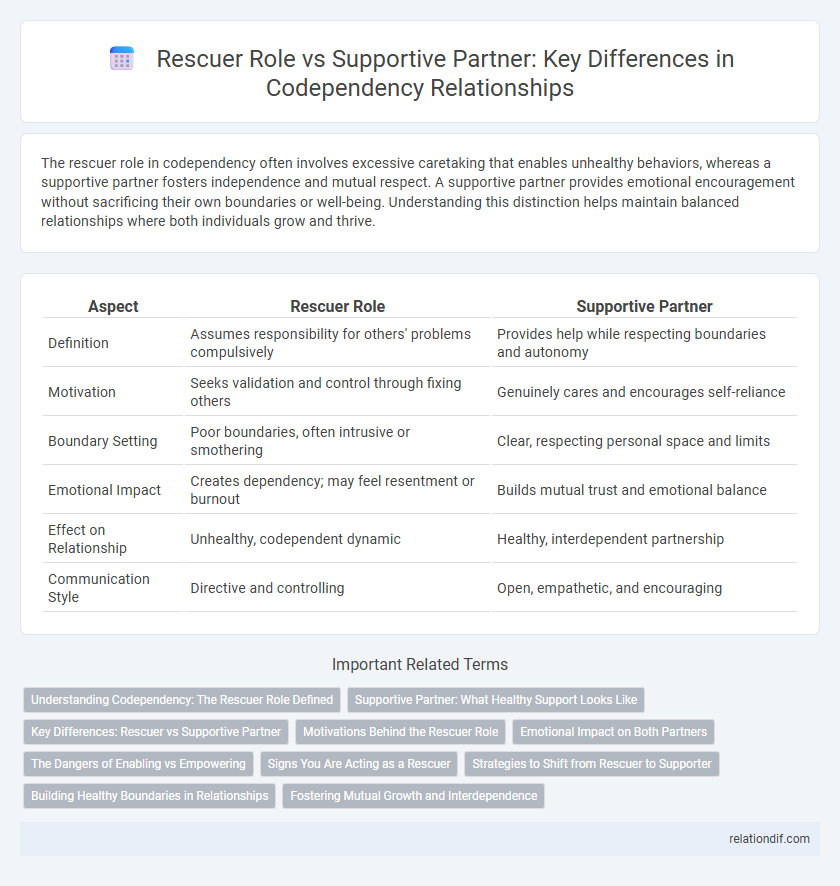The rescuer role in codependency often involves excessive caretaking that enables unhealthy behaviors, whereas a supportive partner fosters independence and mutual respect. A supportive partner provides emotional encouragement without sacrificing their own boundaries or well-being. Understanding this distinction helps maintain balanced relationships where both individuals grow and thrive.
Table of Comparison
| Aspect | Rescuer Role | Supportive Partner |
|---|---|---|
| Definition | Assumes responsibility for others' problems compulsively | Provides help while respecting boundaries and autonomy |
| Motivation | Seeks validation and control through fixing others | Genuinely cares and encourages self-reliance |
| Boundary Setting | Poor boundaries, often intrusive or smothering | Clear, respecting personal space and limits |
| Emotional Impact | Creates dependency; may feel resentment or burnout | Builds mutual trust and emotional balance |
| Effect on Relationship | Unhealthy, codependent dynamic | Healthy, interdependent partnership |
| Communication Style | Directive and controlling | Open, empathetic, and encouraging |
Understanding Codependency: The Rescuer Role Defined
The Rescuer Role in codependency involves compulsively helping others to the point of neglecting personal needs, often driven by a deep-seated desire for approval and control. Unlike a supportive partner who offers balanced empathy and encourages autonomy, the rescuer's behavior perpetuates dependency and prevents healthy boundaries. Recognizing these patterns is crucial for breaking cycles of codependency and fostering mutual respect in relationships.
Supportive Partner: What Healthy Support Looks Like
Healthy support in relationships involves listening actively, respecting boundaries, and encouraging autonomy rather than fostering dependence. A supportive partner offers empathy and practical help without sacrificing their own needs or expecting constant reassurance. This balanced dynamic promotes mutual growth and emotional resilience, distinguishing it from the enabling behaviors typical of the rescuer role.
Key Differences: Rescuer vs Supportive Partner
The Rescuer role in codependency involves excessive, unsolicited help aimed at fixing others' problems, often leading to enabling behaviors and personal neglect. In contrast, a Supportive Partner provides balanced assistance by encouraging autonomy and healthy boundaries while offering emotional support. Key differences lie in motivation and impact: Rescuers seek control or validation through saving, whereas Supportive Partners foster mutual growth and respect.
Motivations Behind the Rescuer Role
The Rescuer role in codependency is driven by a deep need for validation and self-worth, often stemming from unresolved childhood experiences. This motivation leads individuals to prioritize others' problems over their own, seeking approval through constant assistance. In contrast, a supportive partner maintains healthy boundaries, offering help without sacrificing their emotional well-being or autonomy.
Emotional Impact on Both Partners
The Rescuer Role often creates emotional strain by fostering dependency and diminishing autonomy, leading to burnout and resentment for the rescuer and feelings of helplessness for the recipient. In contrast, a Supportive Partner maintains healthy boundaries, promoting mutual respect and emotional growth, which enhances trust and resilience in the relationship. This dynamic reduces anxiety and fosters emotional stability for both partners, supporting long-term relational well-being.
The Dangers of Enabling vs Empowering
The rescuer role in codependency often leads to enabling, where one unintentionally fosters dependency by solving problems for others and hindering their growth. In contrast, a supportive partner empowers by encouraging autonomy, setting boundaries, and promoting self-efficacy, which strengthens individual resilience. Recognizing these differences is crucial to avoid reinforcing unhealthy dynamics and to build mutually respectful and balanced relationships.
Signs You Are Acting as a Rescuer
Signs you are acting as a rescuer in codependency include taking responsibility for others' problems and feeling obligated to fix their issues, often at the expense of your own well-being. You may find yourself constantly overextending to "save" others, ignoring boundaries, and experiencing resentment or burnout. Recognizing these patterns is crucial to shift from a rescuer role to a supportive partner who encourages independence and mutual respect.
Strategies to Shift from Rescuer to Supporter
Shifting from the rescuer role to a supportive partner involves setting clear boundaries and fostering emotional autonomy to prevent enabling behaviors. Encouraging open communication and active listening helps empower others to solve their own problems, strengthening mutual respect. Developing self-awareness through reflection and seeking therapy or support groups enhances the ability to provide balanced support without overstepping.
Building Healthy Boundaries in Relationships
The Rescuer role often leads to blurred boundaries, creating dependency and emotional exhaustion in relationships. In contrast, a Supportive Partner fosters healthy boundaries by encouraging autonomy and mutual respect while offering guidance without overstepping limits. Establishing clear boundaries helps prevent codependency, promoting balanced, empowering connections based on trust and independence.
Fostering Mutual Growth and Interdependence
The Rescuer role in codependency often involves overextending to solve others' problems, which can undermine mutual growth and create imbalance in relationships. In contrast, a Supportive Partner encourages autonomy and fosters healthy interdependence by offering emotional support without enabling dependency. Prioritizing mutual respect and boundaries promotes personal development and strengthens reciprocal connections.
Rescuer Role vs Supportive Partner Infographic

 relationdif.com
relationdif.com